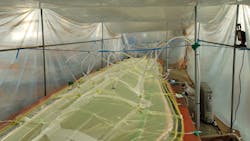Software Seeks Material for Wind-Turbine Blade
Finding the optimum material for a wind turbine blade requires a blend of mass, strength, and durability but when the environment must be protected, the search for a material or mix of materials is even more challenging. Fortunately, the HyperX structural analysis and design software from Collier Aerospace Corp. has shown that it is a powerful tool for developing a long-lasting turbine blade with reduced environmental impact at the end of life. The software was recently applied to the development of a 7.4-m wind-turbine blade as part of a collaboration between the Department of Naval Architecture and Ocean Engineering at Hongik University in S. Korea and software reseller Samwon Millenia, Inc. The software helped replace a blade based on E-glass fiber with one formed from natural plant-based flax fiber reinforcement (see the figure).
The software was used throughout the blade’s structural design, helping determine laminate stacking sequences, ply boundaries, and layup stacking order. Professor Yeonseung (Y. S.) Lee of Hongik University said, “The impressive functionality of Collier Aerospace’s HyperX software made an incredible difference in the design and development of the natural fiber composite wind-turbine blade.” He added: “Since the software optimizes all requirements at once rather than one at a time, it enabled our team to arrive at a workable solution quickly despite the lower mechanical properties of the natural materials. The expert assistance provided by Collier Aerospace helped our team identify a workable blade design that is largely reinforced with natural fibers.”
James Ainsworth, Director of Engineering for Collier Aerospace, detailed some of the challenges: “Design requirements for this wind blade project included cost-effectiveness and reliability at a minimum weight to help maximize annual energy production. Our biggest challenge was meeting performance requirements with natural fiber composites, which do not provide as much stiffness and strength in epoxy resin as E-glass fibers.” The blade developed through the collaborative design efforts is about 7.4% heavier than the original E-glass-fiber-reinforced blade but with much decreased end-of-life environmental impact.
About the Author
Jack Browne
Technical Contributor
Jack Browne, Technical Contributor, has worked in technical publishing for over 30 years. He managed the content and production of three technical journals while at the American Institute of Physics, including Medical Physics and the Journal of Vacuum Science & Technology. He has been a Publisher and Editor for Penton Media, started the firm’s Wireless Symposium & Exhibition trade show in 1993, and currently serves as Technical Contributor for that company's Microwaves & RF magazine. Browne, who holds a BS in Mathematics from City College of New York and BA degrees in English and Philosophy from Fordham University, is a member of the IEEE.
